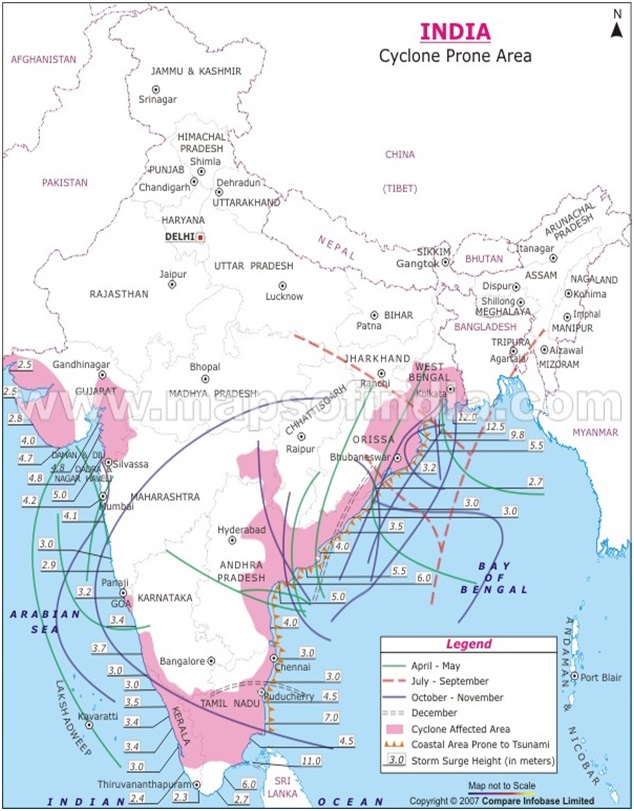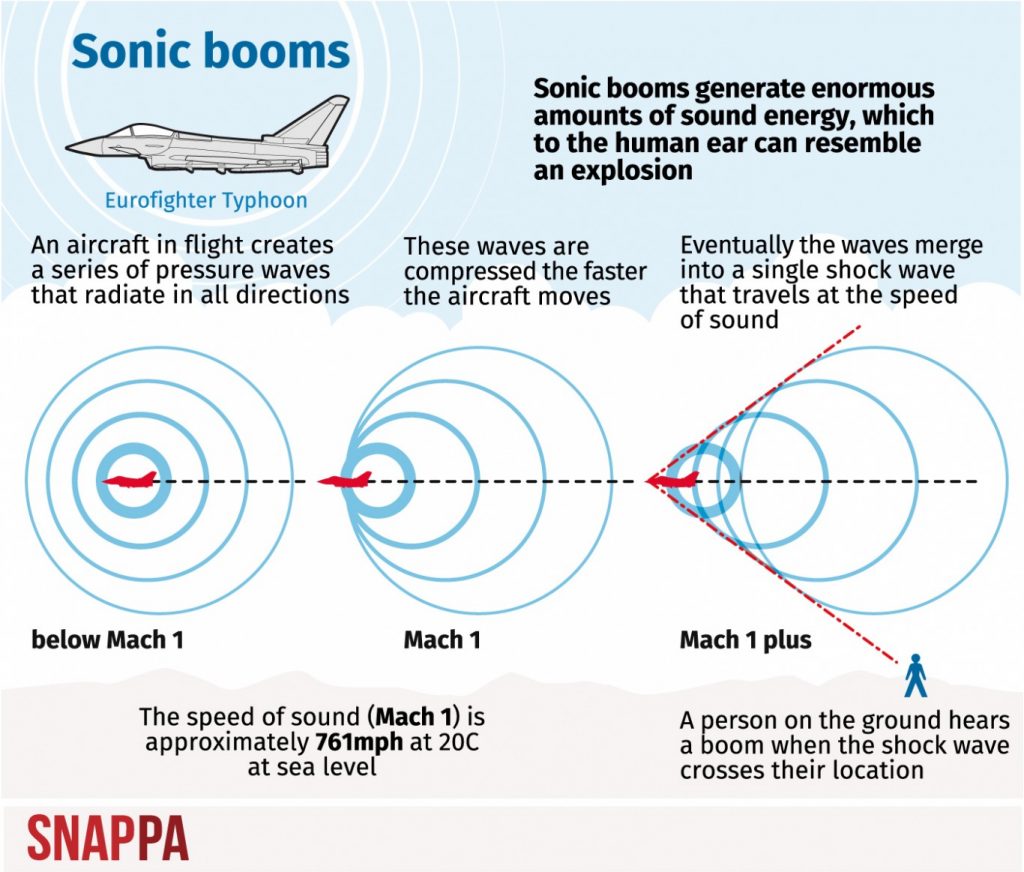Contents
- Amphan brings a message
- Delivering welfare to the beneficiary
- What is the sonic boom that rattled Bengaluru?
- Impact: Dr Harsh Vardhan: WHO Executive Board chairman
AMPHAN BRINGS A MESSAGE
Focus: GS-III Disaster Management
Introduction
The Cyclone Amphan is deemed the most severe storm in the Bay of Bengal since 1999, and it battered the Indian States of West Bengal and Odisha on 20th May 2020.
Steps Once the Cyclone passes
- The states now need to carry out a detailed assessment of what Amphan has done.
- The next phase of work starts now: Rebuilding infrastructure and reaching out to people with food, clean water and medical help.
- Some Important Issues:
- People in temporary shelters would be Homeless
- Farmers would have lost crops and livestock
- Saline water would ingress into fields and homes in Sunderbans: Affecting soil Quality.
Other lessons to learn from the Cyclone
- Cyclone Amphan is also a reminder that oceans are warming due to rising emissions, and warm ocean water is a key ingredient for the formation of tropical cyclones.
- The number of cyclones in the Arabian Sea and the Bay of Bengal has increased by 32% in the last five years, says IMD data.
- However, the solutions — tackling the sources of global warming, and investing in and upgrading climate resilience and adaptation techniques — are complex processes and expensive.
- It also needs tremendous political will and people’s support and participation to ensure that development is sustainable.
- But it has to be done; otherwise, the costs, as Cyclone Amphan has shown, will be massive and recurring.
Analysis: Where do cyclones occur in India?
- More cyclones occur in the Bay of Bengal than the Arabian Sea and the ratio is approximately 4:1.
- The cyclones that occur between Tropics of Cancer and Capricorn are known as Tropical Cyclones.
- These are weather systems in which winds equal or exceed gale force (minimum of 34 knot, i.e., 62 kmph).

Which states are the most cyclone-affected in India?
- Indian sub-continent is the worst affected region of the world, having a coastline of 7516 kms.
- There are 13 coastal states/Union Territories encompassing 84 coastal districts which are affected by cyclones. Four states – Andhra Pradesh, Odisha, Tamil Nadu and West Bengal and one Union Territory – Pondicherry on the East Coast are most vulnerable to cyclone disasters.
- Although cyclones affect the entire coast of India, the East coast is more prone as compared to the West coast.
How are cyclones managed in India?
- A number of structural and non-structural measures can be adopted for effective management of cyclones.
- The structural measures include construction of cyclone shelters, construction of cyclone resistant buildings, road links, culverts, bridges, canals, drains, saline embankments, surface water tanks, communication and power transmission networks etc.
- Non-structural measures involve early warning dissemination systems, management of coastal zones, awareness generation and disaster risk management and capacity building of all the stakeholders.
-Source: Hindustan Times, India TV
DELIVERING WELFARE TO THE BENEFICIARY
Focus: GS-II Social Justice
Why in news?
The Union agriculture ministry had alerted Assam about irregularities in the cash transfer programme for farmers.
Existing Issue with Cash transfer
- It appears, prima facie, that ineligible people signed up for the scheme, which provides ~6,000 a year to farmers with valid documentation.
- With the coronavirus disease pushing more people into poverty and affecting the earning capacity of millions, it is vital that welfare schemes reach the targeted beneficiary in the shortest possible time.
- For many, these schemes are their only source of income now.
The Big Picture view of Issues with Cash Transfer
- A major issue with India’s welfare architecture has traditionally been targeting.
- For schemes which are not universal, reaching the intended beneficiary is a challenge.
- While direct benefits transfer and the Jan Dhan accounts-Aadhaar-mobile phone (JAM) trinity have helped in reducing leakages and eliminating intermediaries, the pandemic will pose new challenges in identifying beneficiaries.
- Many have moved from urban settings to rural areas. As people travel across states due to job losses, the states have to coordinate much more effectively using their own databases and inputs from the Centre.
- As the reliance of citizens on welfare increases, it is incumbent on governments to plug the loopholes in welfare delivery.
Analysis: What is JAM trinity?
- JAM (short for Jan Dhan-Aadhaar-Mobile) trinity refers to the government of India initiative to link Jan Dhan accounts, mobile numbers and Aadhar cards of Indians to plug the leakages of government subsidies.
- Pradhan Mantri Jan-Dhan Yojana is India’s National Mission for Financial Inclusion to ensure access to financial services, namely banking savings and deposit accounts, remittance, credit, insurance and pension in an affordable manner.
- The Unique Identification Authority of India (UIDAI), a central government agency of India, issues a 12-digit unique identity number called Aadhaar to each resident. This is considered the world’s largest national identification number project.
- The government intends to use these three modes of identification to implement one of the biggest reforms in independent India – direct subsidy transfers to the poor.
- Subsidy schemes that take an indirect route like the PDS, the MGNREGA, etc., are more costly to the exchequer, and are also prone to a lot of corruption, as there are a lot of intermediaries before the actual benefit reach the poor.
- With Aadhaar helping in direct biometric identification of disadvantaged citizens and Jan Dhan bank accounts and mobile phones allowing direct transfers of funds into their accounts, it may be possible to cut out all the intermediaries.
-Source: Hindustan Times
WHAT IS THE SONIC BOOM THAT RATTLED BENGALURU?
Focus: GS-III Science and Technology
Introduction
- There was a ‘loud sound’ heard in Bengaluru on 20th May 2020 afternoon, which puzzled lakhs of city dwellers- It was revealed to have emanated from an IAF test flight involving a supersonic profile.
- The sound effect caused due to such high-speed flights is known as ‘sonic boom’.
- Considering the atmospheric conditions and reduced noise levels in the city during these times, the aircraft sound may become clearly audible even if it happened way out from the city.
What is a ‘sonic boom’?

- Sound travels in the form of waves which are emitted outwards from its source. In air, the speed of these waves depends on a number of factors, such as the temperature of the air and altitude.
- From a stationary source, such as a television set, sound waves travel outwards in concentric spheres of growing radii.
- When the source of sound is moving – e.g, a truck– the successive waves in front of the truck get closer together, and the ones behind it spread out. This is also the cause of the Doppler effect– in which bunched waves at the front appear at a higher frequency to a stationary observer, and spread out waves that are behind are observed at a lower frequency.
- As long as the source of the sound keeps moving slower than the speed of sound itself, this source– say a truck or a plane – remains nested within the sound waves that are travelling in all directions.
- When an aircraft travels at supersonic speed – meaning faster than sound (>1225 kmph at sea level) – the field of sound waves moves to the rear of the craft. A stationary observer thus hears no sound when a supersonic flight approaches, since the sound waves are at the rear of the latter.
- At such speeds, both newly created as well as old waves, are forced into a region at the aircraft’s rear called a ‘Mach cone’, which extends from the craft and intercepts the Earth in a hyperbola-shaped curve, and leaves a trail called the ‘boom carpet’. The loud sound that is heard on the Earth when this happens is called a ‘sonic boom’.
-Source: Indian Express
IMPACT: DR HARSH VARDHAN: WHO EXECUTIVE BOARD CHAIRMAN
Focus: GS-II International Relations
Introduction
India would now be playing a more prominent role at the World Health Organisation (WHO), with Union Health Minister Dr Harsh Vardhan set to take charge as chairman of the WHO Executive Board at its 147th session.
The WHO, a specialised agency of the United Nations responsible for international public health, is currently at the forefront of global efforts towards containing the novel coronavirus pandemic. India is a member state of the South East Asia Region at the WHO.
The WHO, WHA and the Executive Board
- The WHO is governed by two decision-making bodies — the World Health Assembly and the Executive Board.
- The WHO headquarters are located at Geneva in Switzerland.
- The World Health Assembly is the decision-making body of WHO.
- It is attended by delegations from all WHO Member States and focuses on a specific health agenda prepared by the Executive Board.
- The Health Assembly is held annually in Geneva, Switzerland (sometimes in special sessions).
- The Executive Board is composed of 34 members technically qualified in the field of health, with members being elected for three-year terms.
- The Board chairman’s post is held by rotation for one year by each of the WHO’s six regional groups: African Region, Region of the Americas, South-East Asia Region, European Region, Eastern Mediterranean Region, and Western Pacific Region.
- The main functions of the Executive Board are to give effect to the decisions and policies of the Health Assembly, to advise it and generally to facilitate its work.
- The Board and the Assembly create a forum for debate on health issues and for addressing concerns raised by Member States.
India at the WHO
India became a party to the WHO Constitution on 12 January 1948.
The first session of the South East Asia Regional Committee was held on October 4-5, 1948 in the office of the Indian Minister of Health, and was inaugurated by Jawaharlal Nehru, the first Prime Minister.
-Source: Indian Express





